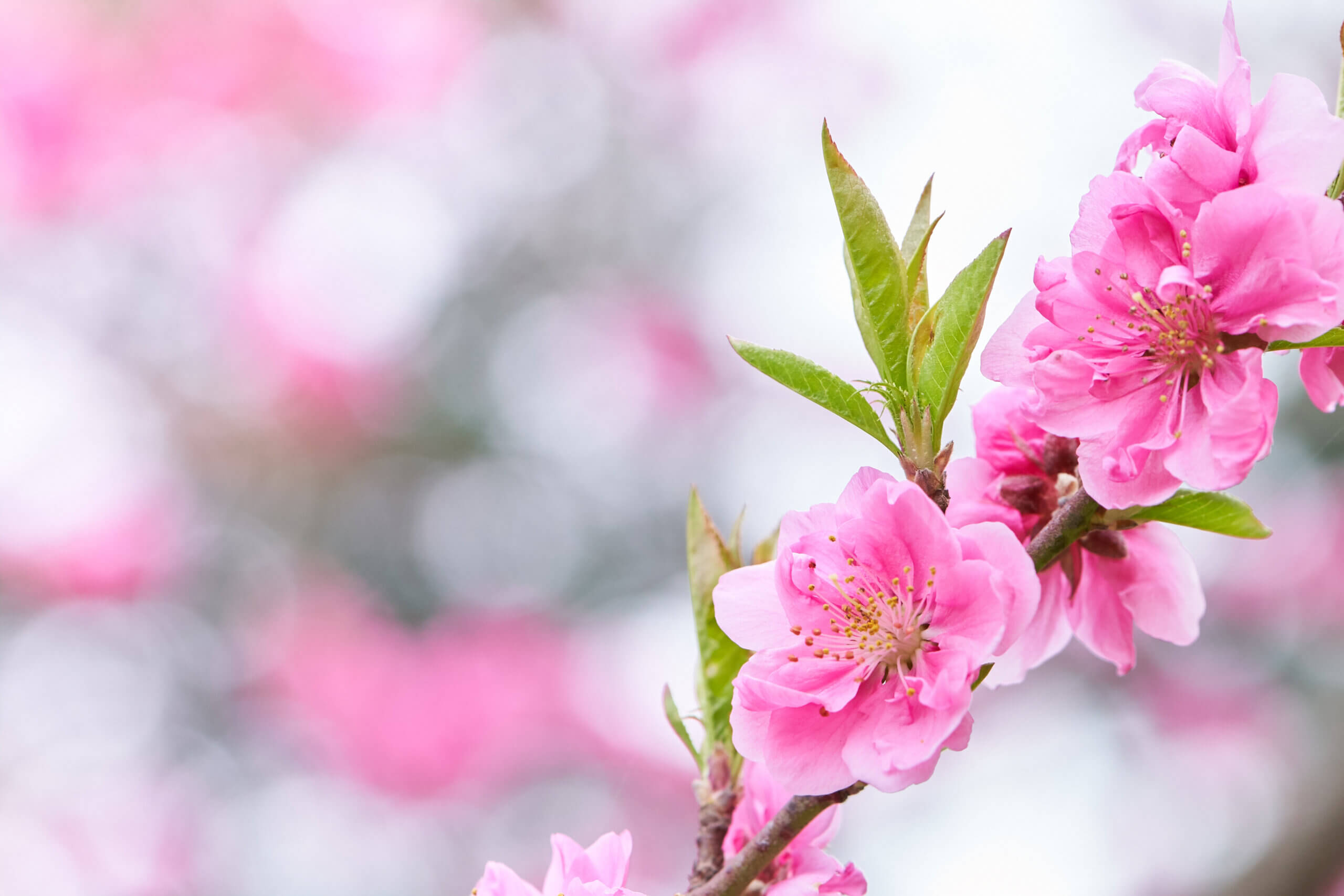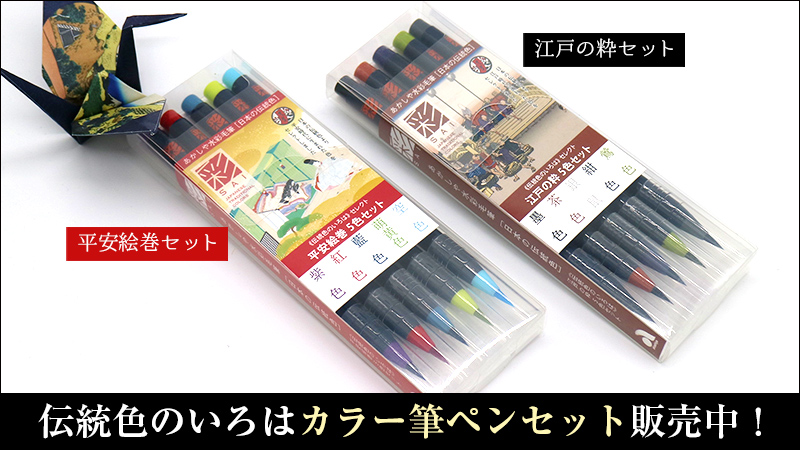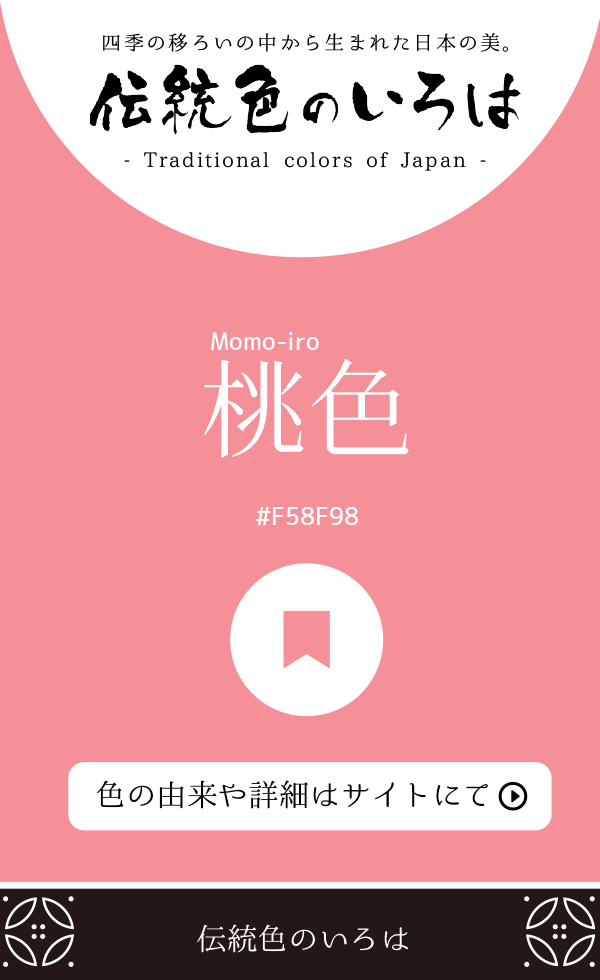| 色の名前Japan Color Name | 桃色(ももいろ) |
|---|---|
| ローマ字Romanized | Momo-iro |
| RGB | R:245 G:143 B:152 |
| CMYK | C:03 M:57 Y:27 K:0 |
| Web カラーHex triplet | |
| 誕辰色 | 3月3日 |
色の説明
桃色(ももいろ)とは、桃の花の色に似た明るく淡い紅色のことです。別名『桃花色 』とも呼ばれ、その名のとおり、桃の花の色に似ていることからこの名が付きました。
「桃」を冠する色の起源は古く、「日本書紀」の天智天皇六年の条には「桃染布 」、衣服令には「桃染の衫 」、「万葉集」にも「桃花褐 の浅らの衣」といった記述が見られ、古くから色としても親しまれてきたことが分かります。
『桃色』として名前が文献に登場するのは室町末期で、能の『謡曲・草子洗小町 』に「もも色の衣や、かさぬらん」という記述があり、桃色が衣服の色として登場しました。
江戸時代の有識故実 「装束色彙 」(一七七八)によれば、『桃染 』は今日 の『桃色』のことであり、『桃花褐 』や『退紅 』は同じ色とあると記されています。ただし、「延喜縫殿式」に示された紅花の使用量から推測すると『退紅』のほうがわずかに淡い色のようです。また『紅梅色』をさらに淡くした色ともいわれます。
なお『桃色』は基本的に紅花で淡く染められた色であり、桃の花で染めたものではありません。桃の花を使っても色が綺麗に出ることはなく、『桃色』の鮮やかさは紅花による染色技法の賜物です。
桃(もも)
桃(もも)は、バラ科スモモ属の落葉小高木。また、その果実や花のこと。原産地は中国。日本へは中国から渡来し、弥生時代には食用として親しまれていた。花期は3月から4月上旬で、薄桃色の美しい花をつける。果期は7月から8月で、果実は赤みがかった白色の薄い皮に包まれている。果肉は水分を多く含み柔らかい。
桃は食用のほか祭祀にも用いられ、古くは邪気を払う力があると信じられていた。三月三日は、桃の花が咲く時期的なものと、桃が病気や災いを払うことから「桃の節句」と呼ばれるようになった。
桃色は、古くから日本の文化に親しまれ、時代を経てその優美さが衣服や装束に取り入れられてきました。現代では、この色相は『ピンク』として広く知られるようになり、ファッションやデザインの分野で多くの人々に愛されています。その柔らかで華やかな色合いは、春の訪れや優しさを象徴する色として親しまれ、これからも多くの人々を魅了し続けるでしょう。
 桃の花
桃の花
-読み:ももいろ-
「帷子は広袖に桃色のうら付を取出せ」
『浮世草子・好色五人女』井原西鶴(一六八六)
関連する色の紹介
[Explanation of a color]
Momo-iro (Peach Pink) refers to a bright and soft reddish color reminiscent of peach blossoms. Also known as "Momohana-iro," the name originates from its resemblance to the color of peach flowers. However, it is important to note that dyeing with actual peach flowers does not produce this color; instead, it is created using diluted safflower dye.
The origin of colors associated with "peach" is ancient. The Nihon Shoki (Chronicles of Japan) from Emperor Tenchi’s sixth year (667 CE) mentions "Tsukisome-no-nuno" (peach-dyed fabric), the Clothing Ordinance refers to "Tsukisome-no-hitoye" (peach-dyed robes), and the Manyoshu includes "Tsukisome no Asara no Koromo" (a robe of light peach-dyed fabric). These records indicate that colors associated with peach have been cherished since ancient times.
The term "Momo-iro" first appears in texts during the late Muromachi period. In the noh play Soshi Arai Komachi (circa 1570), the line "Momo-iro no koromo ya, kasanuran" ("peach-colored robes piled on") suggests that peach pink was recognized as a clothing color.
According to the Shosoku Shikii (Compendium of Court Colors) from 1778, "Tsukisome" referred to a light red akin to modern-day Momo-iro. The text notes that "Tsukisome," "Tsukisome no Asara," and "Ara-some" (light red) are equivalent. However, based on the use of safflower in the Engi Nudonsokushiki (Engi Era Tailoring Guidelines), it is suggested that "Ara-some" was slightly paler. Additionally, it is sometimes described as a softer and lighter version of "Kobai-iro" (plum blossom red).
Momo-iro also appears in layered color schemes for court garments. For example, combinations like "outer: Koki (deep red); inner: Kobai (plum blossom red)" are recorded in texts such as the Koso-sho. However, there are no references to Momo-iro as a clothing color in Heian literature.
Peach pink has long been beloved in Japanese culture and admired for its elegance, appearing in garments and ceremonial attire over the centuries. While today it is more commonly referred to as "pink," its gentle and vibrant hue continues to captivate people around the world.
-read:momo-iro-
参考書籍
- 長崎盛輝『新版 日本の伝統色 その色名と色調』青幻舎 ISBN-10:4861520711
- 吉岡幸雄『日本の色辞典』紫紅社 ISBN-10:4879405493
- 内田 広由紀『定本 和の色事典』視覚デザイン研究所 ISBN-10:4881082035
注意事項
表示されている色(RGB値)は色の名前に対するおおよそものです。色名によっては広範囲の色を指す場合や文献・書籍等によっては解釈が異なる場合もありますのでご了承ください。 ご利用の環境によっては、色が適切に表示されていない場合があります。
印刷などに伝統色を利用したい場合は、DICグラフィックス株式会社から発売されている日本の伝統色シリーズがオススメです。
Pinterestでシェアする際にご利用ください。
サイト運営者からのお願い
このサイトが気に入った、役に立ったと思われた方は、Amazon・楽天で買い物をする際はぜひ下記のバナーをタップしてからお買い物をお願いいたします。
こちらからお買い物をしていただきますと、価格の1%相当のポイントがサイトに入ります。もちろんその分、高くなるようなことはありません。
いただいたポイントは今後のサイト運営のための書籍代や運営費、モチベーションにつながりますので、ご協力いただけますと嬉しいです。

 DIC 日本の伝統色 第9版
DIC 日本の伝統色 第9版



